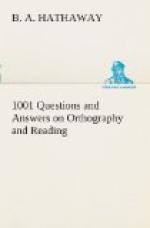35. What is the Falling Circumflex?
The sliding of the voice upward and then
downward on the same sound.
36. What is a Monotone?
Reading without sliding the voice either
upward or downward.
37. Give Rule 1 for falling inflection.
Propositions which make complete sense
require the falling
inflection.
38. Does Emphasis ever reverse this
rule?
It does sometimes.
39. Give Rule 2.
Emphasis generally requires the falling
inflection.
40. Where the sense is dependent, what
inflection is generally
used?
The rising.
41. Does Emphasis ever affect this
rule?
Relative emphasis sometimes reverses it.
42. What kind of inflection should
be used at the end of an
interrogative
sentence?
Falling, if it cannot be answered by yes
or no.
43. Negative sentences require what
kind of inflection?
Rising.
44. Does Emphasis ever affect this
rule?
It does; often reversing it.
45. Imperative sentences have what
inflection?
Usually the falling.
46. What kind of words require opposite
inflection?
Words or members expressing antithesis
or contrast.
47. What is a Series?
A number of particulars following one
another in the same
construction.
48. How many kinds of Series?
Two.
49. What are they?
Commencing and Concluding.
50. What is a Commencing Series?
One that commences a sentence.
51. What is a Concluding Series?
One that concludes a sentence.
52. What inflection is given to the
members of a commencing
series?
The rising.
53. What inflection is given to the
members of a concluding
series?
The falling.
54. Are there any exceptions to these
rules?
There are.
55. What causes the exceptions?
Emphasis.
56. What is a Parenthesis in reading?
A sentence, or clause, set off by curves
from the context.
57. How should the Parenthesis be read?
In a lower tone and more rapidly.
58. What is the use of the Circumflex?
To express irony, or sarcasm.
59. What meaning is always suggested
by the Circumflex?
Doubtful or double meaning.
60. What is the use of the Monotones?
To produce an effect in grave and solemn
subjects.
61. What is Accent in reading?
Increase of force on certain syllables
of a word.
62. Give an example of Emphatic accent.
This corrup’tion must put on in’terruption.




